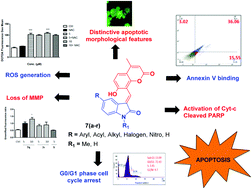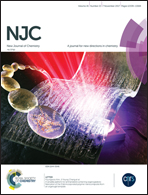Umbelliferone–oxindole hybrids as novel apoptosis inducing agents†
Abstract
In furtherance of our endeavour towards the synthesis of novel bioactive agents, a panel of (E)-3-((7-hydroxy-4-methyl-2-oxo-2H-chromen-8-yl)methylene)indolin-2-one derivatives were synthesized using diverse 5-substituted oxindoles and 7-hydroxy-4-methyl-2-oxo-2H-chromene-8-carbaldehyde (3a). These synthesized analogues were further evaluated for their in vitro cytotoxic activity against MDA-MB-231 (breast), MCF-7 (breast), DU145 (prostate), PC-3 (prostate) and A549 (lung) cancer cell lines by employing the 3-(4,5-dimethylthiazol-2-yl)-2,5-diphenyltetrazolium bromide (MTT) assay. Among all the synthesized compounds, compounds 7q (IC50 = 9.52 and 9.9 μM) and 7r (IC50 = 15.3 and 11.7 μM) showed the most significant cytotoxicity towards DU145 and PC-3 cancer cell lines respectively. Compounds 7q and 7r were found to be comparatively safe towards normal human prostate epithelial (RWPE-1) cells. The apoptosis inducing effect of compounds 7q and 7r on PC-3 and DU145 cancer cells was further investigated using the annexin V-FITC/propidium iodide staining assay, which confirmed the increase in the percentage of early apoptotic cells. Moreover, the cell cycle analysis revealed cell cycle arrest particularly at the G0/G1 phase in the PC-3 and DU145 cells. In addition, the treatment with compounds 7q and 7r led to collapse of the mitochondrial membrane potential (DΨm) and increased levels of reactive oxygen species (ROS) in the PC-3 and DU145 cells. Western blotting was performed to examine the appearance of active forms of cytochrome c and cleaved PARP (Poly ADP ribose polymerase), indicator proteins of apoptosis in PC-3 cells; the study confirmed the triggering of the mitochondrial mediated apoptotic pathway upon exposure to compounds 7q and 7r.



 Please wait while we load your content...
Please wait while we load your content...